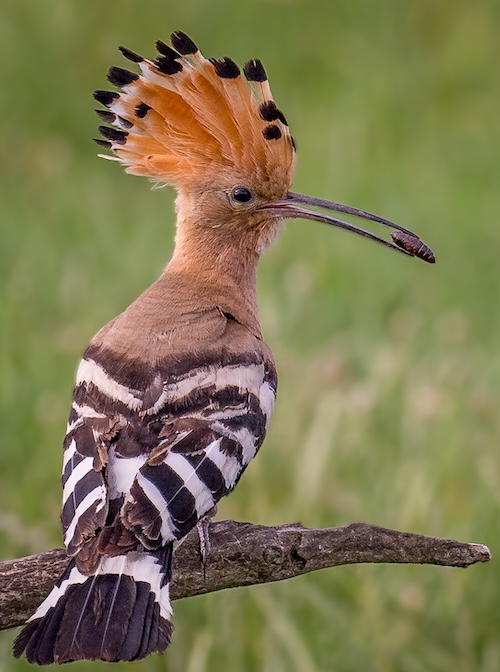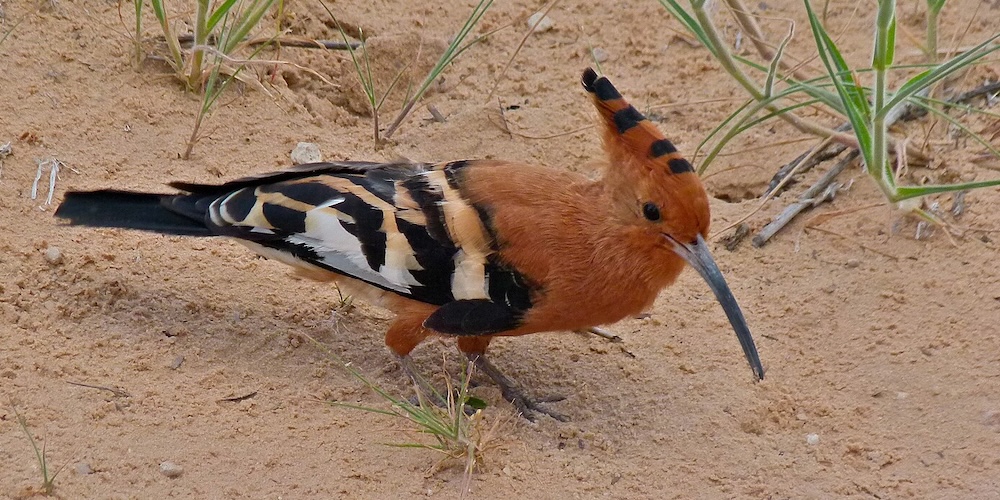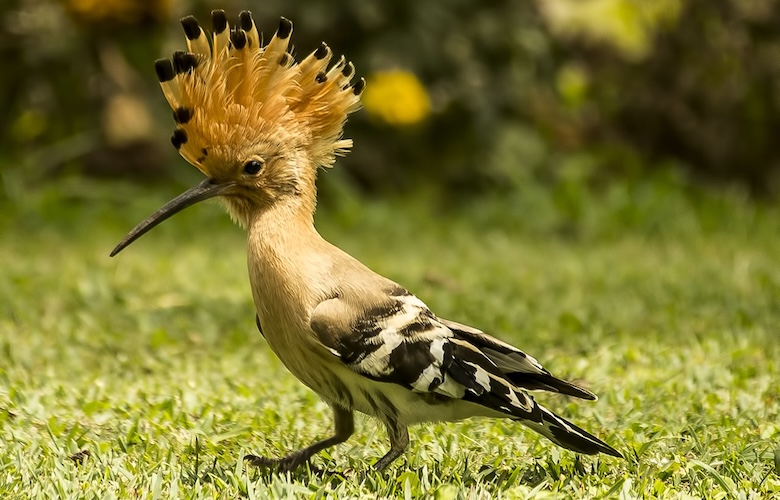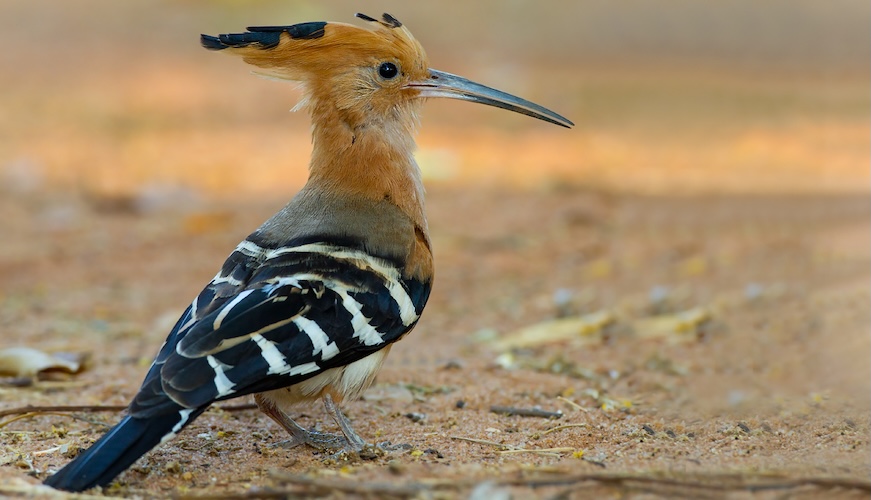Upupidae – Hoopoes

The Upupidae are a small family of near passerine birds. They are medium-sized birds, 25cm to 32cm long, with a 44cm to 48cm wingspan. They weigh 46g to 89g. They are highly distinctive, with a long, thin, slightly decurved, tapering bill that is black with a fawn base. They have a striking crest pointing back from the back of the head until raised in an exotic and spectacular display. The strengthened musculature of the head allows the bill to be opened when probing inside the soil. The hoopoe has broad and rounded wings capable of strong flight; these are larger in the northern migratory species. They have a characteristic undulating flight, which is like that of a giant butterfly, caused by the wings being half closing at the end of each beat or short sequence of beats. The colouring giving it a chequered appearance in flight. Adults may begin their moult after the breeding season and continue after they have migrated for the winter.
Their call is typically a trisyllabic oop-oop-oop, which may give rise to its English and scientific names, although two and four syllables are also common. An alternative explanation of the English and scientific names is that they are derived from the French name for the bird, ‘huppée’, which means crested. In the Himalayas, the calls can be confused with that of the Himalayan Cuckoo Cuculus saturatus, although the cuckoo typically produces four notes.

African Hoopoe Upupa africana – ©Bernard Dupont CC BY-SA 2.0 via Wikimedia Commons
Other calls include rasping croaks and hisses when alarmed. Females produce a wheezy note during courtship feeding by the male. Both sexes, when disturbed, call a rough charrrrrr, strongly reminiscent of the warning cry of the Eurasian Jay. The food begging call of the nestlings is similar to that of a common swift: tiiii.
In what was long thought to be a defensive posture, hoopoes sunbathe by spreading out their wings and tail low against the ground and tilting their head up; they often fold their wings and preen halfway through. They also enjoy taking dust and sand baths.

Common Hoopoe Upupa epops – ©Antony Grossy CC BY 2.0 via Wikimedia Commons
Their diet is mostly composed of insects, although small reptiles, frogs and plant matter such as seeds and berries are sometimes taken as well. They are solitary foragers, which typically feed on the ground. More rarely they will feed in the air in pursuit of numerous swarming insects, where their strong and rounded wings make them fast and manoeuvrable. More commonly their foraging style is to stride over relatively open ground and periodically pause to probe the ground with the full length of their bill. Dung-heaps are a favourite haunt probing for insects in the soft material. Insect larvae, pupae and mole crickets are detected by the bill and either extracted or dug out with the strong feet. Hoopoes will also feed on insects on the surface, probe into piles of leaves, and even use the bill to lever large stones and flake off bark. Common diet items include crickets, locusts, beetles, earwigs, cicadas, ant lions and ants. These can range from 10mm to 150mm in length, with a preferred prey size of around 20mm to 30mm. Larger prey items are beaten against the ground or a preferred stone to kill them and remove indigestible body parts such as insect wings and legs.

Madagascar Hoopoe Upupa marginata – ©Dubi Shapiro
Many authorities consider the Eurasian Hoopoe (Upupa epops), which is a colourful bird found across Eurasia, notable for its distinctive crown of feathers, to be the only extant Hoopoe. Others have elevated African Hoopoe and Madagascar Hoopoe to full species.
-
Number of bird species: 3
Some authorities have long treated African Hoopoe as a full species, further research is needed and it is regarded (in the unified world list) as a race of Common Hoopoe. The other races are included below for future reference:
Common Hoopoe Upupa epops
Upupa epops saturata
Upupa epops ceylonensis
Upupa epops longirostris
Upupa epops major
Upupa epops senegalensis
Upupa epops waibeli
African Hoopoe Upupa (epops) africana
Madagascan Hoopoe Upupa marginata
St Helena Hoopoe Upupa antaios (Extinct)
-
The Eurasian Hoopoe
| Everything You Could Want to Know About This Iconic Bird | By Neville James Davies | (privately published by author | 2024 | Paperback | 189 pages, 53 colour photos and colour & b/w illustrations | ISBN: 9780957538719 Buy this book from NHBS.com
-
Upupidae
Family AccountHoopoes are colourful birds found across Africa, Asia, and Europe, notable for their distinctive "crown" of feathers which can be raised or lowered at will.
-
African Hoopoe Upupa africana
Species AccountSound archive and distribution map. -
African Hoopoe Upupa africana
Species AccountThe African hoopoe is a species of hoopoe in the family Upupidae. Previously considered as a subspecies of the hoopoe, due to its vocalisations and small differences in plumage, it is otherwise similar to that species. -
Common Hoopoe Upupa epops
Species AccountThe Hoopoe Upupa epops is in the same order of often colourful near passerine birds as the kingfishers, bee-eaters, and rollers. -
Common Hoopoe Upupa epops
Species Account -
Common Hoopoe Upupa epops
Species AccountSound archive and distribution map. -
Madagascan Hoopoe Upupa marginata
Species AccountSound archive and distribution map. -
Madagascan Hoopoe Upupa marginata
Species AccountThe Madagascan hoopoe (Upupa epops marginata) is a subspecies of hoopoe in the Upupidae family. It is often considered as a full species (Upupa marginata), separate from the hoopoe, due to its vocalisations and small differences in plumage, but it is otherwise similar to the rest of the species.
